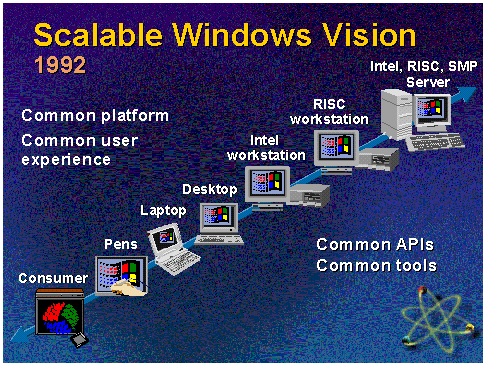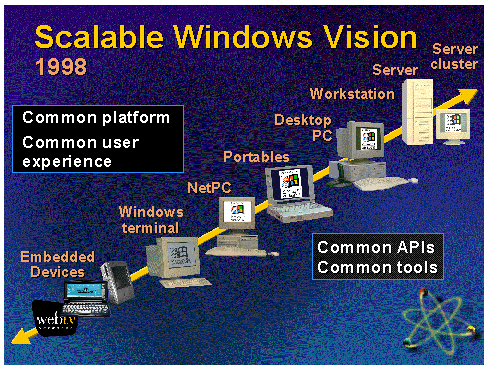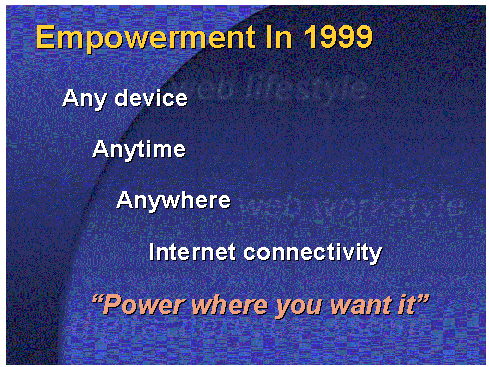
November 29, 1999
The good doctor had the opportunity to work the MSDN Online booth at Comdex last week. It was quite an experience to be in Las Vegas and at Comdex for the first time -- and wonderful to meet many of you.
Astute long-time readers will remember that Dr. GUI went to Comdex a few years ago and disappeared in the desert afterwards. But frankly, the good doctor remembers nothing of the experience -- so, for all intents and purposes, this was Dr. GUI's first time at Comdex, and in Las Vegas.
Las Vegas is amazing. The good doctor has never seen so many fabulous luxury hotels -- let alone all in a row! Each has a theme -- an Egyptian theme at the Luxor; city themes at New York, New York, Paris, and the fabulous Venetian; and even a pirate theme at Treasure Island. As he landed in Las Vegas and saw the spectacle, Dr. GUI wondered where all the money came from to build these hotels.
It didn't take long to find out: As soon as he was off the plane, the doctor was confronted by the first of thousands (maybe millions) of slot machines he would encounter during his visit. At the airport gate. Clearly, this was a town built by gambling.
Now, the good doctor doesn't have a moral objection to gambling, but it was obvious from the plush surroundings that the odds weren't exactly stacked in his favor. So he kept most of his money in his pocket as he wandered by the one-armed bandits -- although he couldn't resist the quarter slots. On his first spin, he won two quarters. He promptly lost them, and didn't win again. (Total loss: $1, plus $1 from the token given out at the show by the Windows 2000 training team.)
Dr. GUI left with this advice for future conference attendees: If you go, be prepared for the long walk through the casino from the front desk to your room. And it's dry, so be sure to bring a water bottle.
After arriving Sunday and installing the MSDN Library on the booth computers, Dr. GUI relaxed a bit. Then he went to hear Bill Gates's keynote speech.
The good doctor knows that Bill's keynote is popular, but he had no idea he'd have to walk past all of the 10,000 or so people who actually got tickets (by arriving as early as 10:00 A.M. for a 7:00 P.M. speech). Dr. GUI finally ended up in an overflow room watching the speech on a projection TV.
Bill talked about the "Personal Web," where users can access the information, goods, and services they want -- anytime, any place, and from any device. The Personal Web is built on top of Web services -- Web sites exposing their functionality to other sites and to users' PCs so that the Web can be programmed. In other words, each Web site can publish its own API. Other Web sites can access these services via the published interfaces, allowing them to use the services without having to re-create or screen scrape them.
The data format used to access Web services will be XML, which means that Web sites will be able to interoperate with each other regardless of the different platforms on which they run. It's nearly impossible to overemphasize how important XML is becoming.
Bill also talked about the advantages -- lower cost, greater scalability, and higher reliability -- of using a cluster of smaller computers to run a Web site rather than using one large computer. He demonstrated this by ordering a new Ford Focus on stage. As he was placing his order, the server that contained his order was shut down and removed from the rack. But because of Windows 2000 Advanced Server's network load balancing, the order was intact and placed.
Once the car was delivered to the stage, the real fun began. (It was especially fun because Dr. GUI's colleagues wrote this part of the demo.) Bill used a variety of Web services to help plan his trip back home in his new car. Ford provided some of the services, even communicating with the car's GPS receiver and computer to find the car's location, gas mileage, and maintenance schedule. (In essence, the car provided these services.) A mapping service provided route information and even queried (again, via Web services) gas stations along the way to plan the least-expensive gas stops. And because the car was new, it would need an oil change about halfway there, so the application used another Web service to schedule an oil change appointment en route.
Bill used a separate Web service to select some music to download into the car, and paid for it with a final Web service.
This scenario is complicated -- and probably impossible today. But with Web services and common XML formats, it will be easy to access sophisticated services from any application using any server or client -- and really exciting and comprehensive applications can be built.
Bill also showed off one of MSN's new Web Companion devices. These are very simple Windows CE devices that deliver Web browsing and e-mail capabilities for users who don't need all the power of a PC -- or maybe don't need a second or third PC.
Bill's speech really highlighted just how the world of software development is evolving. Microsoft sees that an increasing portion of its business will come from providing software services rather than selling packaged software. Perhaps your company's business will undergo a similar shift.
This won't happen overnight, but it pays to think about how the changes might occur and how to embrace the changes instead of being dragged along by them.
You can check out a summary of Bill's speech at http://www.microsoft.com/misc/features/comdex99_billg.htm. This page also has links to the transcript and video.
Another nice thing about Comdex is that a lot of industry leaders are sharing their views of the future in keynote addresses. Because of scheduling problems, Dr. GUI wasn't able to attend as many of these as he would have liked; he went only to Bill's, Linus Torvald's, and Scott McNealy's.
As different as these folks are, Dr. GUI was struck by the convergence of some of the important ideas about computing they expressed. For instance, Linus spent a good deal of time talking about all the different devices that could run on Linux. That brought to mind some slides that Dr. GUI (and probably you) have seen in Microsoft talks over the years. Here's one modeled after a slide shown in 1992.

Here's last year's version of that slide. The names have changed, but the idea is the same.

These slides have been so common over the years that Dr. GUI once saw a parody of them entitled "Barney Everywhere," featuring Barney CE, Barney TV, Barney 98, Barney NT, and Barney NT Advanced Server Cluster.
But if you replaced the word "Linux" with the word "Windows," in Linus's talk, Bill almost could have given a good hunk of it.
Dr. GUI's point isn't to say that the Linux world is suffering from a lack of innovation. Rather, the fact that Linus and Bill are thinking similar thoughts about API compatibility across devices is a pretty good indication that such compatibility is a very good thing -- and that the industry is in some ways converging on a set of good ideas.
The code doctor found more evidence of convergence when both Bill Gates and Scott McNealy emphasized software as services, and in the idea that these services should be available anywhere, anytime, on any device, over a ubiquitous Internet. In fact, McNealy had the words "Anyone," "Anytime," "Anywhere," and "Anything" projected onto the backdrops behind him for almost all of his speech. (Sun also had hundreds of banners around about Comdex. One cute one read "Anyone. Anywhere. Anytime. Anydevice. Anyquestions?") But others in the industry have had these ideas, too. Check out this slide from a talk Bill Gates gave in April at Windows World.

The spelling is changed, but the ideas are remarkably similar. Dr. GUI doesn't recall seeing this much agreement among competitive industry leaders about where the industry is going any time in the past 20 or so years.
But there are some major differences. Dr. GUI was struck by Linus Torvald's clarity about the Linux user base: It's a mix of developers and users, often in the same organizations. In other words, running Linux more or less requires that you have some developers on staff, ready to fix problems and provide enhancements. (The good doctor notes that some of the dozen or so companies selling Linux distributions would argue with this conclusion.) Other operating systems are sold under a model in which the seller or systems integrator is responsible for making it work -- no developers required. That frees developers for writing applications -- the programs that make an operating system actually useful. Which model is better for you? It depends.
The differences couldn't have been starker between Gates's model of a huge variety of devices all interconnected and McNealy's server-centric, centrally controlled model. There are times when having your data on a server is a very good thing -- but not always. It's better to be able to do useful work even if you're not connected to the Internet at the moment -- something that's difficult in Sun's view of the world. (If the network is the computer, no network means no computer. When was the last time you saw a Java or Solaris laptop?)
There's money to be made from big servers. Sun posted a huge banner on a parking garage near the Las Vegas Convention Center that read, "Scott McNealy doesn't want your money" -- referring to the fact that application service providers can license StarOffice for free if they don't charge their customers. Whether you believe that McNealy doesn't want your money, the banner begs the question: What does he want? The banner is clearly incomplete. How should it be finished?
During a lunch, some of us came up with an idea: "Scott McNealy doesn't want your money. He wants your soul." And if you lock yourself into a centralized server architecture, he'll get both.
Even Dr. GUI acknowledges there's a place for server-based computing: Microsoft will soon offer Office Online (over the Web -- both directly and via Application Service Providers), WebTV, and MSN's Web Companions. And Web apps are truly the hot development opportunity. So server-based computing has a very important place in the world. The good doctor just thinks it shouldn't be your only option.
Many more folks spoke at Comdex. You can check out all of the keynotes and many other interviews at the Comdex Webcast site: http://daily.zdevents.com/comdex/fall99/webcast/.
It's becoming clearer all the time that Windows 2000 will have what it takes to be a great operating system for many uses: for laptops, for PCs at work and home, and for servers.
From Dr. GUI's perspective, these are the only good reasons not to run Windows 2000 on your PC:
If you're not in one of the above categories, you'll want to upgrade. Windows 2000 is speedy, reliable, feature-laden, loyal, thrifty, brave, clean, reverent, and trustworthy. It will make life better for you just as it has for Dr. GUI.
And Windows 2000 is becoming more and more capable of handling the most demanding tasks. The demo during Bill Gates's keynote showed that Windows 2000 could scale and be reliable. But Dr. GUI saw something else at the show that really knocked his socks off.
Unisys ran an incredible demonstration of how systems built with Windows 2000 can offer state-of-the-art reliability and scalability -- right on the Comdex floor.
In the center of their booth area was an enclosed room that contained 20 Web servers, 6 servers running COM+ middle-tier objects, and a clustered SQL Server 7.0 database server. In addition, there were a number of systems that simulated customers visiting the e-commerce site -- at the rate of 3 billion Web hits a day (three times as many daily hits as were estimated for the entire Internet last month), generating 4,000-8,000 database transactions per second. The machines generated so much heat that the cooling system used 125 gallons of water a minute (and raised the temperature of each gallon about 30 degrees Fahrenheit).
During the five days of Comdex, the system processed the equivalent of all of the e-commerce transactions during last year's Christmas shopping season worldwide, generating a database spanning 9 terabytes. (Recall that a terabyte is 1,000 gigabytes, and a gigabyte is 1,000 megabytes -- so 9 terabytes is one big database!)
And it did all this without crashing. The MicroNews (Microsoft's internal newsletter) quoted Unisys Integration Architect Dave Jones as saying, "In the four months of testing we did, we only really had one blue screen, and we caused it by using a non-standard driver for some of the cards we were using. We've been very happy with both its performance and stability."
Dr. GUI seconds that motion. Since he's installed Windows 2000, he's totally forgotten what a computer crash is. Until he uses his home machines.
But if Windows 2000 is as reliable as this, what will Linus Torvald and Scott McNealy razz Microsoft about? We'll see.
During breaks from working the MSDN booth, Dr. GUI had a chance to wander around the trade show. Even though it's not as big as in years past, Comdex is huge: It's spread over two different convention centers (the Sands Convention Center and the Las Vegas Convention Center). It's so huge, in fact, that Dr. GUI missed most of one of the large display halls.
The variety of displays is incredible. Huge companies, small companies. Companies from all over the world. Scores of companies making keyboards, motherboards, mouse devices, power supplies, cases (some in iMac-inspired translucent colors), software, monitors, sound cards, cameras, digital audio players, USB devices, computers in incredible form factors, and a few devices Dr. GUI couldn't quite figure out. In all of this, a couple of things stood out.
ClearType was announced last year at Comdex, so technically it's not new. But it's better than it was even a few months ago -- enough better that the ClearType team is getting ready to ship its first product, Microsoft Reader (http://www.microsoft.com/reader/, early next year.
In case you've forgotten, ClearType technology uses characteristics of LCD displays to make text seem less jagged and more like printed type on paper, thereby making the type easier to read. ClearType will make electronic books possible. And Microsoft Reader will have Dr. GUI's must-have feature: a built-in dictionary.
(By the way, Dr. GUI saw a number of large pen-sized scanners, some of which had dictionaries -- so you can quickly get the definition of a word you're reading in printed material.)
Dr. GUI is most excited, however, about Bluetooth personal area networking technology. Bluetooth is wireless data transmission at about one megabit per second within a 10 meter radius. It can be used to connect any two devices -- laptops to peripherals or LANs, cell phones to PDAs, and headsets to cell phones. In other words, there are a wide variety of applications, especially as the cost comes down.
Dr. GUI saw prototype cell phones with Bluetooth built in -- no larger than a normal cell phone. (One was, in fact, a Motorola StarTac -- the same model as the good doctor's beloved phone.) And companies were announcing PC/MCIA, CF, and Handspring Springboard modules with Bluetooth. That means that your laptop or PDA can use your Bluetooth-enabled cell phone for its connection to the Internet, giving you easy connectivity to any service in the world. All without wires. Dr. GUI can hardly wait -- but he'll have to, until sometime next year. (He'd love to be a beta tester.)
Dr. GUI spent most of the week on the show floor talking with customers at the MSDN Online booth. Although he brought his lab coat, stethoscope, and reflector, the good doctor didn't put 'em on at first; he thought they were too "over the top." A quick trip around the show floor to see the outrageous things other companies were doing convinced Dr. GUI that it wouldn't be out of line at all to wear them, so he did, starting Tuesday.
Although Comdex isn't a developers-only show, many of you recognized the good doctor and stopped by to say "Hi!" Dr. GUI thanks all who did -- especially those with tough questions.